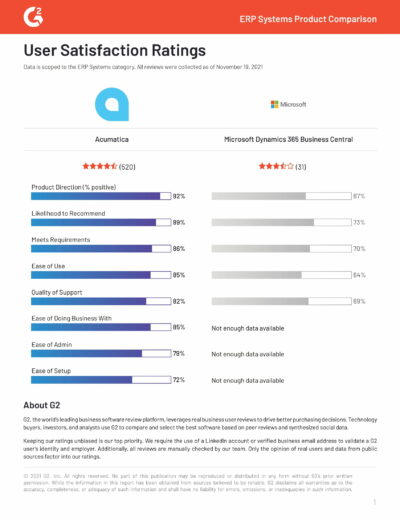Microsoft Dynamics NAV (formerly Navision) is a mid-market ERP product offering: flexibility and customizability, third-party software support, support for vertical industries
Acumatica vs Microsoft Dynamics NAV
Feature Comparison
| Functionality | Acumatica | Microsoft Dynamics NAV |
|---|---|---|
| True cloud* (built for cloud) | ||
| True mobility (supports all devices with no special apps) | ||
| Full function ERP | ||
| Full relational database export | ||
| Customization using industry standard tools | ||
| Upgrade on your schedule | ||
| Flexible licensing options based on customer requirements | ||
| Multiple deployment options | ||
| Scale as you grow | ||
| Superior Return on Investment (ROI) |
What are our customers saying after replacing a Microsoft Dynamics Product with Acumatica?
Background
Dynamics NAV was originally developed in the 1980s. It was a great product then, and, although many improvements have been made over the years, it still uses the same proprietary code, the same data structures, and the same client-server architecture. Microsoft Dynamics NAV’s much older system architecture becomes an issue in scenarios designed for the latest technologies, including cloud deployment options, customizations using current development tools, and integration with CRM.
Microsoft has rearchitected NAV to make it cloud compatible and rebranded the product as Microsoft Dynamics 365 Business Central. However, Business Central still uses the old software at its core, and legacy on-premises NAV users will find that upgrading to Business Central will require rewriting all customizations to meet the new Business Central requirements—an expensive proposition. See how Acumatica compares to Business Central.
Conversely, Acumatica was designed from the start to be accessible through the cloud using modern web technology. This lets Acumatica offer more features and functions than Dynamics NAV and at a lower price. In addition, Acumatica offers a completely integrated ERP and CRM solution for the price of system resources, whether deployed on-premises or in the cloud. And with Acumatica, you enjoy unlimited users, you only pay for system resources. We believe Acumatica provides the best price/value, performance, functionality, and ease of use of any ERP product available for small- and medium-sized businesses.
In the end, we encourage you to perform due diligence when considering the purchase of any ERP system. Kick the tires. Ask questions. And look seriously at your business requirements over the next three to five years. Make sure you get the ERP system that is right for your company now and in the future.
See the G2 Crowd survey showing how users compared Acumatica against Microsoft Dynamics NAV, GP, and 365.
Make sure you take some time to review Acumatica’s ERP software selection resources to help you find the solution that is right for you.
Watch this quick (3 minute) demonstration of Acumatica in action.
Similiarities
For many businesses, the decision comes down to deciding between Acumatica and Microsoft Dynamics NAV. Which one do you choose?
- Flexibility and customizability
- Third-party software support
- Support for vertical industries
Differentiators
“True cloud” means all functionality is accessible through the internet using a standard browser without the need for any additional software installation on the user’s device or additional software licensing. Acumatica works on-premises or in the cloud without additional equipment or software. Dynamics NAV is a traditional client-server product and was NOT built for the cloud. NAV can be HOSTED on a remote server, but requires the addition of a web server (IIS) to provide web support.
Out-of-the-box, the entire Acumatica suite can be accessed using a standard web browser. Acumatica’s web pages are built to resize to whatever device you are using for every page and every screen. Moreover, every screen has the same information and flow, whether it is on a PC, tablet, or phone. In contrast, Dynamics NAV requires coding to support resizing custom pages for phone and tablet access.
Both products are highly configurable, but Acumatica is built using industry-standard C# and .NET. Dynamics NAV uses a proprietary development language, making customizations more difficult and expensive. Plus, there are additional costs for development privileges.
Both products have licensing options for customers to choose from, depending on each customer’s needs. But NAV charges per user, while Acumatica employs a consumption-based pricing model (unlimited users) so you’re not penalized for growth by having to add users.
When choosing an ERP solution, you must consider not just your company’s current needs, but the future needs as well. Both products allow you to scale resources to support a growing company. But because Acumatica only charges by the by computing power required and not by users, you can scale your resources as you grow, allowing an unlimited number of users to access the system regardless of their role. Dynamics NAV, on the other hand, is licensed by user. As your company grows and more employees, customers, and suppliers need access to the system, the costs rise quickly. Be aware of these costs and consider them in your final evaluation.
Acumatica charges by computing power used, not by user. Dynamics NAV charges per user, and these costs increase as your company grows. In addition, Dynamics NAV requires a license for SQL Server to run, where Acumatica can work not only with SQL Server, but also with less expensive databases, such as MySQL. Moreover, Acumatica works natively in the cloud; Dynamics NAV requires a separate license for IIS for it to work in the cloud.
 Canada (English)
Canada (English)
 Colombia
Colombia
 Caribbean and Puerto Rico
Caribbean and Puerto Rico
 Ecuador
Ecuador
 India
India
 Indonesia
Indonesia
 Ireland
Ireland
 Malaysia
Malaysia
 Mexico
Mexico
 Panama
Panama
 Peru
Peru
 Philippines
Philippines
 Singapore
Singapore
 South Africa
South Africa
 Sri Lanka
Sri Lanka
 Thailand
Thailand
 United Kingdom
United Kingdom
 United States
United States


